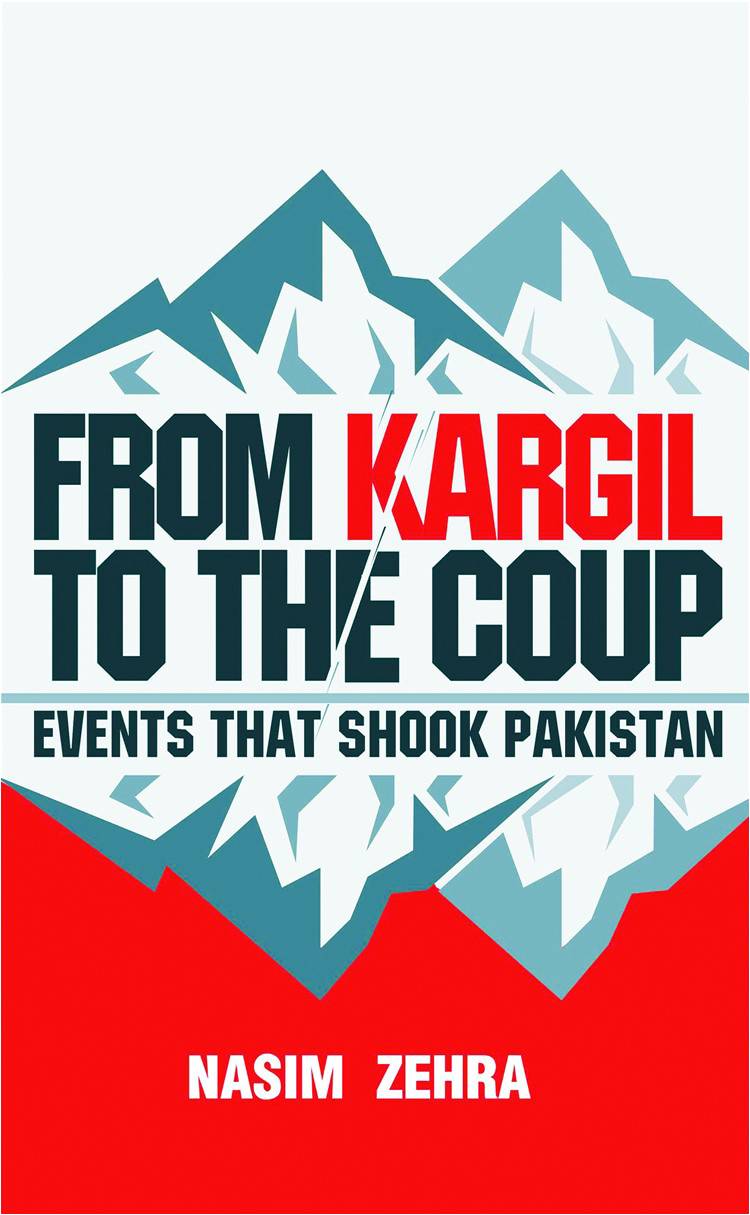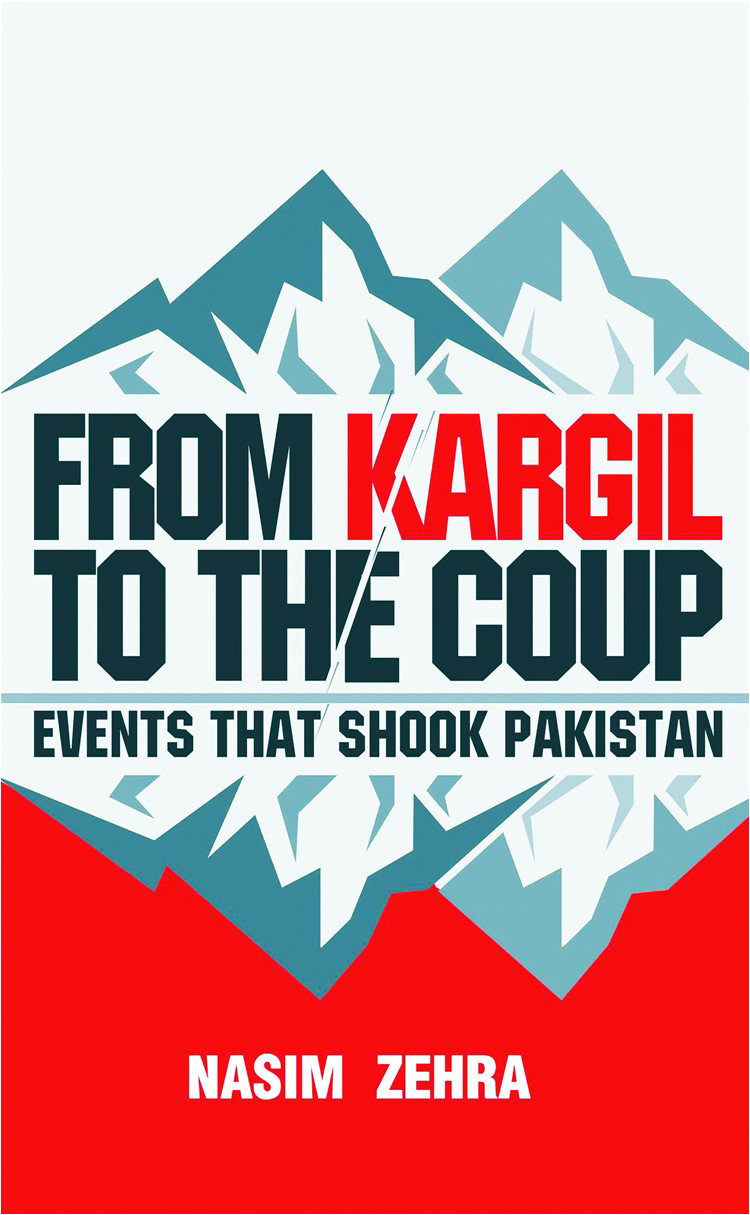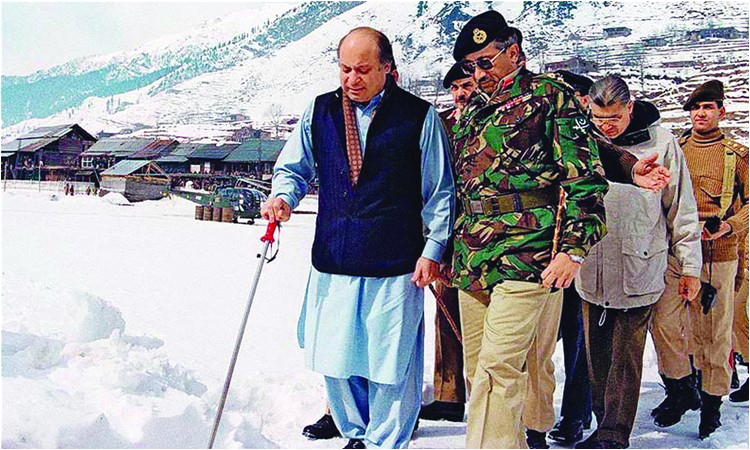
The Kargil story or “misadventure” is now well known, thanks in no small part to Nasim Zehra’s chilling thriller From Kargil to the Coup: Events that shook Pakistan.
The book was published last year, twenty years after the event. You can understand why it took so long when you peruse the copious end notes, bibliographies and interviews that went into its writing even while Zehra was engaged in hosting and conferencing other projects. As an unintended consequence, we can now trash the earlier, opportunist and self-serving accounts of the same story by Major-General (r) Javed Hassan, commander FCNA, one of the Gang of Four (others being then Chief of Army Staff General Pervez Musharraf, Chief of General Staff Lieutenant General Mohammad Aziz and Lieutenant General Mahmud Ahmed of 10 Corps) who secretly planned and executed the misadventure, and Dr Shirin Mazari, who partly paid off her debt to the brass for appointing her head of the Institute of Strategic Studies in Islamabad.

Zehra outlines the story in six phases. First, the “euphoria phase” in which the Kargil clique deluded themselves into believing in the military and diplomatic success of the planned operation, underestimating or miscalculating the response of the enemy. Second, the “excitement phase” when the operation on the ground was so successfully completed that it emboldened the planners to increase their physical outreach in the Kargil sector without sufficiently planning for adverse consequences. This is characterised as the “expansion phase”. Fourth, the “encounter phase” in early May when limited hostilities began, with neither side quite sure of the aims, objectives and relative strengths of the other. This is also the time when the secretive Kargil Clique finally revealed the Kargil blueprint and operation to the Pakistani Prime Minister Nawaz Sharif and to the wider military high command. Within a month, the Kargil Op had snowballed into a full-fledged battle with India throwing its air force and heavy Bofors artillery into the theatre and bringing the underprepared Pakistani troops under unbearable physical and psychological pressure. Fifth, the “exit phase” beginning in mid-June when it became clear to the Pakistanis that the operation had backfired with serious loss of troops and morale and mounting global condemnation so that an exit strategy had to be worked out. Sixth, the “effect phase” started with Nawaz Sharif’s dash to Washington on July 4, President Bill Clinton’s mediation with Indian Prime Minister Atal Vajpayee and consequential Pakistani troop withdrawal from Kargil under heavy fire from the Indians, resulting in loss of men and materials. The net effect of this “debacle” led to mounting distrust and acrimony between a stunned Sharif and his cabinet and an arrogant Musharraf and his blundering clique that eventually panned out into Sharif’s failed attempt to kick out Musharraf and Musharraf’s successful coup against him in October 1999.
Zehra is also careful to address core issues impacting on decision-making. First, she says, “There is no evidence that the Kargil Clique kept the prime minister in the loop on its plan to cross over the LoC to set up dozens of posts on the Kargil heights to finally choke the Drass-Kargil Highway.”
Second, she points out that “while individuals within both ISI and MI appear to have attempted to investigate, both agencies failed to pick up anything indicating unusual troop movements.” Third, the Pakistani military was on a winning military curve only until the encounter phase, after which it plunged to rock bottom. Fourth, “neither in the valley, nor in Delhi, nor at the international level, did the Kargil Op help to take the Kashmir issue any closer to a solution,” This was one of the core justifications for its planners.

Fifth, there were no rational or realistic reasons for the international community to force India to buckle under their pressure - another core assumption of the planners. Sixth, at no stage was there any nuclear signalling or nuclear blackmail by Pakistan’s high command (thank Goodness!) Seventh, the US took advantage of the situation to invest in strategic trust-building with India instead of with Pakistan - the planners had assumed the opposite. Eighth, there was no opportunity for backchannel bilateral diplomacy because there was no incentive for India in view of the US tilt in its favour. Ninth, Nawaz Sharif’s dash to Washington was predicated on two erroneous assumptions: that the US would get some concessions from India on Kashmir as a quid pro quo for pressurising Pakistan to make a unilateral withdrawal; and that the US could pressurise Musharraf not to overthrow the government. Tenth, given the distrustful internal power play triggered by the operation, a coup was inevitable, either by Sharif against Musharraf or vice versa, and that is exactly what happened.
There are several takeaways from Zehra’s book. One, a small clique in the military high command led by the army chief was able to launch a strategic operation against India with disastrous consequences, with several hundred troops, over a nine-month period without the ISI, MI, MO and other corps commanders and service chiefs being in the loop. This testifies to the extreme discipline and operational efficiency of the Pakistan Army no less than an ever-present possibility of reckless and irrational behaviour and action on the part of its independent high command. For a million-strong army that boasts nuclear weapons and has not been averse to tactical nuclear-rattling, this is a frightening realisation.
The book was published last year, twenty years after the event. You can understand why it took so long when you peruse the copious end notes, bibliographies and interviews that went into its writing even while Zehra was engaged in hosting and conferencing other projects. As an unintended consequence, we can now trash the earlier, opportunist and self-serving accounts of the same story by Major-General (r) Javed Hassan, commander FCNA, one of the Gang of Four (others being then Chief of Army Staff General Pervez Musharraf, Chief of General Staff Lieutenant General Mohammad Aziz and Lieutenant General Mahmud Ahmed of 10 Corps) who secretly planned and executed the misadventure, and Dr Shirin Mazari, who partly paid off her debt to the brass for appointing her head of the Institute of Strategic Studies in Islamabad.

Zehra outlines the story in six phases. First, the “euphoria phase” in which the Kargil clique deluded themselves into believing in the military and diplomatic success of the planned operation, underestimating or miscalculating the response of the enemy. Second, the “excitement phase” when the operation on the ground was so successfully completed that it emboldened the planners to increase their physical outreach in the Kargil sector without sufficiently planning for adverse consequences. This is characterised as the “expansion phase”. Fourth, the “encounter phase” in early May when limited hostilities began, with neither side quite sure of the aims, objectives and relative strengths of the other. This is also the time when the secretive Kargil Clique finally revealed the Kargil blueprint and operation to the Pakistani Prime Minister Nawaz Sharif and to the wider military high command. Within a month, the Kargil Op had snowballed into a full-fledged battle with India throwing its air force and heavy Bofors artillery into the theatre and bringing the underprepared Pakistani troops under unbearable physical and psychological pressure. Fifth, the “exit phase” beginning in mid-June when it became clear to the Pakistanis that the operation had backfired with serious loss of troops and morale and mounting global condemnation so that an exit strategy had to be worked out. Sixth, the “effect phase” started with Nawaz Sharif’s dash to Washington on July 4, President Bill Clinton’s mediation with Indian Prime Minister Atal Vajpayee and consequential Pakistani troop withdrawal from Kargil under heavy fire from the Indians, resulting in loss of men and materials. The net effect of this “debacle” led to mounting distrust and acrimony between a stunned Sharif and his cabinet and an arrogant Musharraf and his blundering clique that eventually panned out into Sharif’s failed attempt to kick out Musharraf and Musharraf’s successful coup against him in October 1999.
In a damning indictment, Zehra castigates the civil-military leadership and institutions of “not being positioned for responsible and clear-headed decision-making”
Zehra is also careful to address core issues impacting on decision-making. First, she says, “There is no evidence that the Kargil Clique kept the prime minister in the loop on its plan to cross over the LoC to set up dozens of posts on the Kargil heights to finally choke the Drass-Kargil Highway.”
Second, she points out that “while individuals within both ISI and MI appear to have attempted to investigate, both agencies failed to pick up anything indicating unusual troop movements.” Third, the Pakistani military was on a winning military curve only until the encounter phase, after which it plunged to rock bottom. Fourth, “neither in the valley, nor in Delhi, nor at the international level, did the Kargil Op help to take the Kashmir issue any closer to a solution,” This was one of the core justifications for its planners.

Fifth, there were no rational or realistic reasons for the international community to force India to buckle under their pressure - another core assumption of the planners. Sixth, at no stage was there any nuclear signalling or nuclear blackmail by Pakistan’s high command (thank Goodness!) Seventh, the US took advantage of the situation to invest in strategic trust-building with India instead of with Pakistan - the planners had assumed the opposite. Eighth, there was no opportunity for backchannel bilateral diplomacy because there was no incentive for India in view of the US tilt in its favour. Ninth, Nawaz Sharif’s dash to Washington was predicated on two erroneous assumptions: that the US would get some concessions from India on Kashmir as a quid pro quo for pressurising Pakistan to make a unilateral withdrawal; and that the US could pressurise Musharraf not to overthrow the government. Tenth, given the distrustful internal power play triggered by the operation, a coup was inevitable, either by Sharif against Musharraf or vice versa, and that is exactly what happened.
There are several takeaways from Zehra’s book. One, a small clique in the military high command led by the army chief was able to launch a strategic operation against India with disastrous consequences, with several hundred troops, over a nine-month period without the ISI, MI, MO and other corps commanders and service chiefs being in the loop. This testifies to the extreme discipline and operational efficiency of the Pakistan Army no less than an ever-present possibility of reckless and irrational behaviour and action on the part of its independent high command. For a million-strong army that boasts nuclear weapons and has not been averse to tactical nuclear-rattling, this is a frightening realisation.

